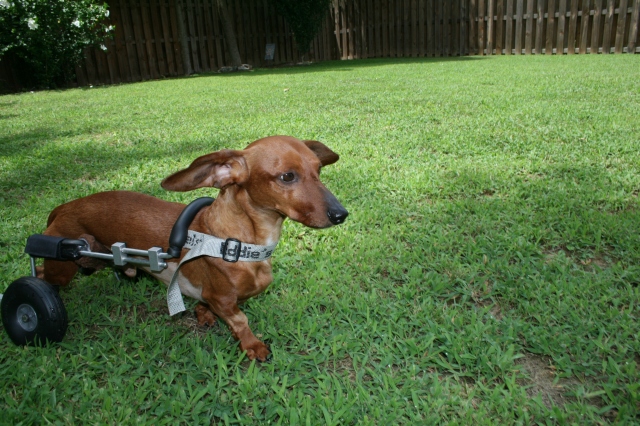Some of you have met my little Killian in past blog entries or on his Facebook page. One thing I don’t talk a lot about with Killian is how incredibly difficult he can be to medicate. Now, I am not new to medicating dogs. I have even been hired by clients to come over and give medication to difficult dogs. But Killian is a master at avoiding his pills.

When I first got Killian I actually took him to the vet every day so they could give him his meds. Killian is not just paraplegic. He also suffers from epilepsy and chronic hepatitis. He takes a lot of medication to keep him going.
Killian is a small dog, so one would expect that, at the very least, I could force the pills down him. And I have. But Killian has learned how to cheek them or keep them just in the top of his throat where I cannot see them. As soon as I turn my back on him, ptooey! And he has some range – on occasion over six feet. The pill ends up across the room, and I am on my knees trying to locate it. Because not only are his pills varied for each condition, some of them are also extremely expensive.
So I feel your pain if you have a dog that is difficult to pill. Here are the options I have used over the years. Not all work with all dogs, but I find that usually one of them does work.
- Wrapping the pill in something yummy is usually sufficient for most dogs. American cheese works well if you don’t want to purchase pill pockets. Or a small piece of bread can work in a pinch.
- Peanut butter is an experience all its’ own when pilling dogs. Some dogs it works well. They cannot help but smack their lips and lick and swallow the delicious gooey mess.
- Force is my least favorite way to pill a dog, but in life or death situations it may be necessary. I always feel terrible opening a dogs mouth by force. But if you need to do it, the easiest way is to place your hand over your dog’s muzzle with the thumb on one side and your index finger on the other. Find the gap in the teeth (about half way back) and press in. You will find you can gently pull the mouth open. Place the pill as far back in the mouth as you can and close the dog’s mouth, holding the head in a normal position (parallel to the ground). Sometimes rubbing the throat will help the dog swallow. Gently hold the muzzle closed long enough that the dog swallows the pill.
Yeah, I know. If you are reading this you have probably tried all of this. I certainly tried and failed with all of these methods with Killian. A few tweaks can turn these failures into success. Here are the tweaks!
- Try the “Meatball Game”: Get three pieces of whatever you are wrapping your dog’s pill in. Roll two into balls, and put the pill in the third one. One at a time, toss each “meatball” to your dog. Save the pill for last. Usually by the time your dog gets to the third one he’s gobbling them up.
- Use something that is doughy to wrap the pills. Lunch meat may be delicious to your dog, but it doesn’t always stay on the pill well. Use something that will squish around the pill and completely encase it. You might even look online for recipes for homemade pill pockets.
- Use a chaser: Get something your dog can’t resist eating and feed it to her immediately after putting the pill in her mouth. I’ve used broth in a syringe, but it doesn’t necessarily have to be a liquid as long as it goes down easily.
- These methods have worked for me in every case that didn’t involve disease induced anorexia. If the dog isn’t eating you’re going to have to resort to putting the pill in your dogs throat. If this is the case, look for a piller for your dog. This is a syringe type tool that will get the pill to the back of the throat without risking that your dog will bite down on your hand in an attempt to keep you from forcing the pill down. It also keeps your hand drool free.
Hopefully this gives you some new tools to help get medicine down your dog. Making this as easy as possible for your dog will make it easier for you, and will make it easier to pill her in the future.

You must be logged in to post a comment.